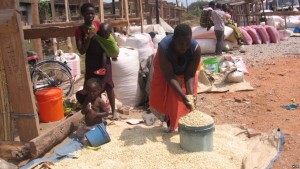
How can Malawi’s trade and export policies on agricultural products best support dual goals of food security and growth in the agriculture sector? Exploring this important topic, IFPRI presented research results at a “Dissemination Workshop on Export Bans and Minimum Farm Gate Prices Study” organized by the Ministry of Industry and Trade (MoIT), at the Capital Hotel on August 24, 2016. The research project was funded by the ASWAP-SP Multi-Donor Trust Fund. The workshop was opened by Mrs. Christina Chatima, Director of Trade, MoIT and Alex Namaona, Director of Agricultural Planning Services, Ministry of Agriculture, Irrigation and Water Development (MoAIWD), and involved participants from government, donor organizations and private sector. IFPRI researchers then presented a summary of the results of the project, followed by a discussion concerning its policy implications. The project documents (listed below) can be read and downloaded on our website. The main topic of the workshop was the impact of trade restrictions and other market interventions on agricultural exports from Malawi, with a special focus on maize and soya. The presentations covered analyses of the trading environment, crop allocation decisions of smallholder farmers under risk, the disincentives facing large-scale producers, and modeling the impact of trade restrictions on the economy. Current interventions, such as export restrictions, the minimum farm gate price of maize, and the Farm Input Subsidy Program (FISP) were considered, as well as potential alternative, less distortionary interventions.
The main findings and policy recommendations of the workshop were:
- Export bans are usually ineffective (non-binding) as domestic market prices typically exceed the export parity price.
- The farm gate price for maize set by MoAIWD is usually set very high, only has a limited effect on observed prices, and is not enforceable in marketing negotiations.
- Large-scale farmers generally showed interest in producing commercial maize either for export or sale to the government. However, numerous discretionary interventions in export and domestic markets have turned them into ‘subsistence producers’, who only produce maize for seed or provisioning their own workers. Clear and enforceable contracts are needed for commercial maize production to be re-established.
- As long as farmers are continuing to produce maize for their subsistence, a farm model showed that there is no large income effect to reduce rural poverty possible.
- To promote transparency and reduce the volatility of prices, government should convene a formal platform for open communication on maize production, prices and trading. Furthermore, to ensure a more stable market, especially for exports, it should refrain from ad hoc interventions in trade. Finally, it should follow through on its commitments on prices, procurement & trade, and engage in predictable, rules-based market operations
During the discussion, the government explained that there is already an intervention planned, to motivate large-scale farmers to produce maize for the domestic market, which can prevent Malawi from being a net maize producer. Additionally, representatives of MoIT explained that the revision of the Control of Goods Act, which is currently underway and is expected to be finalized in early 2017, will support Malawi`s export activities through improved transparency of government actions.
Project outputs can be read and downloaded here:
- Are Malawi’s maize and soya trade restrictions causing more harm than good? A summary of evidence and practical alternatives. MaSSP Policy Note 25.
- Have maize market policies turned Malawi’s large scale farmers into subsistence maize producers? MaSSP Policy Note 24.
- Achieving food security and industrial development in Malawi: Are export restrictions the solution? MaSSP Working Paper 15.
- A Farm Level Perspective of the Policy Challenges for Export Diversification in Malawi: Example of the Oilseeds and Maize Sectors. IFPRI Discussion Paper 1549
